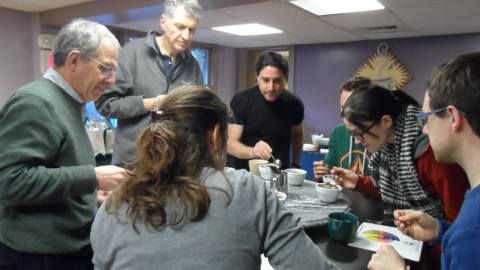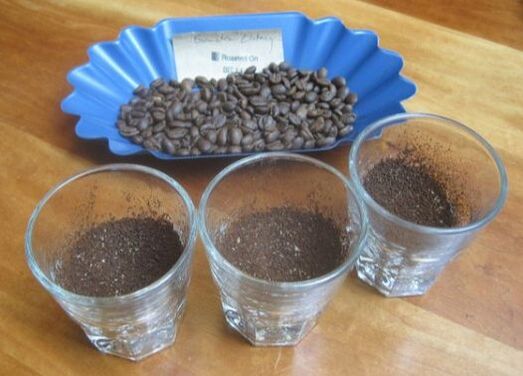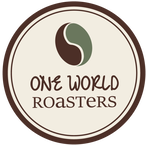How We Cup Our Coffees
|
Cupping our coffee is an essential process for us at One World Coffee Roasters, and it's how we know we're providing you with the most delicious coffees possible!
Our evaluation includes smelling and inspecting the green beans, roasting and grinding the sample, smelling during roasting and grinding, testing the aroma, and finally, tasting the coffee. If all steps are conducted properly, we have an accurate coffee flavor profile. We buy green coffee beans from importers and then cup our freshly-roasted coffees to evaluate their flavor profiles. Each cupping reveals different flavor notes and a number of factors can influence a cup's attributes. |
Terroir refers to the actual soil in which the coffee tree was grown, and accounts for variables like growing environment as well as cultural and local traditions that influenced the processing of the coffee cherries. Agronomic practices, in growing and producing coffee cherries, are also important to the objectives of producing, selecting, and picking the most red, ripe cherries. The steps of the production cycle can enhance or weaken cup attributes.
Cupping for flavor enables One World to evaluate the merits of each and every coffee we roast. Keeping our clients in mind, we hold high expectations for our coffee products and continually re-evaluate them to give you nothing but the very best roasts possible.
Cupping for flavor enables One World to evaluate the merits of each and every coffee we roast. Keeping our clients in mind, we hold high expectations for our coffee products and continually re-evaluate them to give you nothing but the very best roasts possible.
How we comply WITH SCAA GuidelinesTo ensure complete cupping of coffee quality, we follow these guidelines as set by The Specialty Coffee Association of America:
Step #1 – Fragrance/Aroma Within 15 minutes after samples have been ground, the dry fragrance of the samples should be evaluated by lifting the lid and sniffing the dry grounds. After infusing with water, the crust is left unbroken for at least 3 minutes but not more than 5 minutes. Breaking of the crust is done by stirring 3 times, then allowing the foam to run down the back of the spoon while gently sniffing. The Fragrance/Aroma score is then marked on the basis of dry and wet evaluation. |
Step #2 – Flavor, Aftertaste, Acidity, Body, and Balance
When the sample has cooled to 160º F (71º C), in about 8-10 minutes from infusion, evaluation of the liquid should begin. The liquid is aspirated into the mouth in such a way as to cover as much area as possible, especially the tongue and upper palate. Because the retro nasal vapors are at their maximum intensity at these elevated temperatures, Flavor and Aftertaste are rated at this point.
As the coffee continues to cool (160º F - 140º F), the Acidity, Body and Balance are rated next. Balance is the cupper's assessment of how well the Flavor, Aftertaste, Acidity, and Body fit together in a synergistic combination.
As the coffee continues to cool (160º F - 140º F), the Acidity, Body and Balance are rated next. Balance is the cupper's assessment of how well the Flavor, Aftertaste, Acidity, and Body fit together in a synergistic combination.
Step #3 – Sweetness, Uniformity, and Cleanliness
As the brew approaches room temperature (below 100º F) Sweetness, Uniformity, and Clean Cup are evaluated. For these attributes, the cupper makes a judgment on each individual cup, awarding 2 points per cup per attribute (10 points maximum score). Evaluation of the liquor should cease when the sample reaches 70º F (21º C) and the Overall score is determined by the cupper and given to the sample as "Cupper's Points" based on ALL of the combined attributes.
Step #4 - Scoring
After evaluating the samples, all the scores are added as describe in the "Scoring" section below and the Final Score is written in the upper right hand box.
When the sample has cooled to 160º F (71º C), in about 8-10 minutes from infusion, evaluation of the liquid should begin. The liquid is aspirated into the mouth in such a way as to cover as much area as possible, especially the tongue and upper palate. Because the retro nasal vapors are at their maximum intensity at these elevated temperatures, Flavor and Aftertaste are rated at this point.
As the coffee continues to cool (160º F - 140º F), the Acidity, Body and Balance are rated next. Balance is the cupper's assessment of how well the Flavor, Aftertaste, Acidity, and Body fit together in a synergistic combination.
As the coffee continues to cool (160º F - 140º F), the Acidity, Body and Balance are rated next. Balance is the cupper's assessment of how well the Flavor, Aftertaste, Acidity, and Body fit together in a synergistic combination.
Step #3 – Sweetness, Uniformity, and Cleanliness
As the brew approaches room temperature (below 100º F) Sweetness, Uniformity, and Clean Cup are evaluated. For these attributes, the cupper makes a judgment on each individual cup, awarding 2 points per cup per attribute (10 points maximum score). Evaluation of the liquor should cease when the sample reaches 70º F (21º C) and the Overall score is determined by the cupper and given to the sample as "Cupper's Points" based on ALL of the combined attributes.
Step #4 - Scoring
After evaluating the samples, all the scores are added as describe in the "Scoring" section below and the Final Score is written in the upper right hand box.



